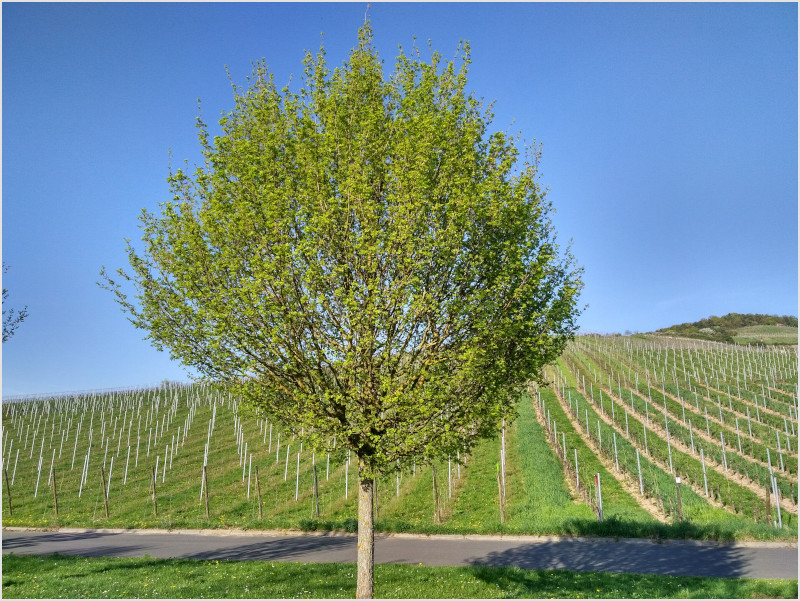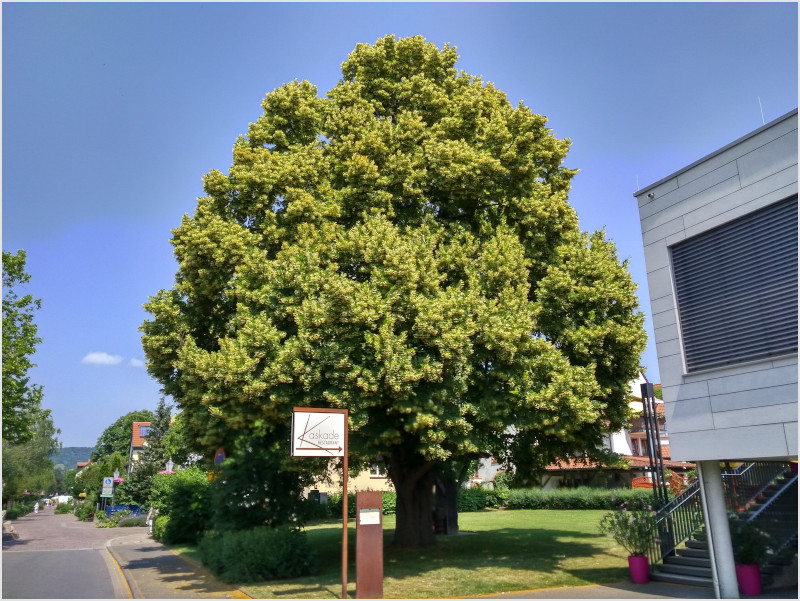Weather data as evidence of climate change.
By Klaus Körber
The extreme weather conditions of the summers 2015 to 2018 have left visible traces on many woody plants in wide regions of Germany. Especially 2018 with relatively high temperatures often well above 35 degrees and extremely low rainfall has also led to major damage to woody plants in regions such as the Ammerland or Schleswig-Holstein. The brown band from Vienna to Kiel was only broken where stronger thunderstorms caused partly high amounts of precipitation.
The green or brown colouring of grass and meadows as well as the height of maize in August serve as indicators of drought stress and are closely related to the condition of adjacent trees.
Especially difficult locations such as motorway embankments, planted car parks or tree plantations at roadsides show extreme damage patterns.
Dependence of the trees on the location and its water capacity
However, there are often only slightly damaged woody plants of the same species in the vicinity of these stress trees, but then usually on naturally grown soils with a good credit rating and a correspondingly positive water capacity.
Drought stress lays the foundation for the damage.
Klaus Körber
So it is not primarily the heat that causes the greatest damage, but the drought stress that lays the foundation for the damage and, in combination with hot days, makes life so extremely difficult for the trees. The same tree species, such as hornbeam or lime, showed a significantly better appearance in direct comparison on good agricultural soils or, above all, with a sufficient water supply and adequate standing space, even at temperatures of up to 40 degrees.
There were always beautiful Norway and sycamore maples in the late summer of 2018, but only where there was water in the subsoil and a large rootable root space. Accordingly, the subject of intelligent and permanent watering must be given much greater attention in the future. This costs a lot of money, but is a prerequisite for successfully establishing young trees in the long term and preparing them for future climate conditions.
Regardless of location, there is a ranking of the various woody species in terms of their drought tolerance when they are placed side by side in direct comparison. Such comparative plantings are located at the LWG in Veitshöchheim, but also at the experimental station in Quedlinburg in Saxony-Anhalt. On the ten-hectare trial site of the LWG Veitshöchheim, an extensive assortment of well over 400 tree species and varieties has been planted on an area of about three hectares over the last 15 years.
Observations on trees in late summer 2018
Field maple is by far the best native maple, doing comparatively very well on numerous sites; only on extremely poor sites with brown leaves but almost always much more stable than Norway maple and sycamore. Whereby both Norway maple and, with detractions, sycamore, on unpolluted soils with sufficient root space, have in some cases borne the heat and drought much better than was to be expected.
The native oaks, certainly also because they are better able to tap water due to their deep root system, but above all also the oaks from the Near East could and can tolerate drought much better than e.g. the lime trees. The oak - including Quercus rubra, the red oak - was and is currently one of the few trees that "looks good" with rich dark foliage throughout Germany. It is a pity that in practice the oak processionary moth very much limits the acceptance of oaks in new plantings

Lime trees have shown enormously severe leaf and crown damage almost all over Germany in 2018, with first and sometimes very heavy leaf fall starting in July. Only on the best soils and with a sufficiently large stand area were there no problems. The group of silver lime trees can be classified somewhat better in this respect, although Tilia tomentosa must also be continuously supplied with water in the juvenile phase.

The legumes such as black locust, cordwood and the gleditsias are mostly very stable on dry and poorer sites, even after this summer. They have merely started their autumn colouring a little earlier. The group of resistant elms impressed with their tremendous toughness and vigor in heat and drought. Alnus x spaethii and, for that matter, the Italian alder Alnus cordata presented very stable and reliable growth in 2018. Mulberry has shown why it is one of the most planted woody plants in the front and middle east. It is to be hoped that the advance of the mulberry scale insect will not lead to restrictions in its use.
The plane tree stands well to very well in German cities despite Massaria, powdery mildew and net bugs. Perhaps the use of the occidental plane tree and its slender-growing varieties should also be tested more intensively. This is also because Platanus orientalis is the dominant shade tree in the hot streets of cities such as Istanbul or Tehran.
The native ash trees, which are not affected by the fungus, have shown a very high tolerance to heat and drought. The same is true for Fraxinus ornus and Fraxinus pennsylvanica and their cultivars, which, by the way, have not been affected by ash shoot dieback under our conditions so far. One of the winners of summer 2018 is the walnut, which is showing great vitality everywhere. The same applies - with some reservations, because it does not grow so well on lime - to Castanea sativa, the chestnut.
Trees with greater problems depending on location
The visual "losers", especially on extremely dry or constricted urban sites, are birch, beech, the red and white flowering chestnuts, Norway and sycamore maple, the common Sorbus and Crataegus species and cultivars (except Carrierei) and a large part of the predominant linden assortment. Hornbeams are heavily browsed in dense mixed plantings; only on sites with large root space can beautiful hornbeams still be seen.
The tree hazel, but also the robinia, also belong to those trees that often fail on problematic, constricted and compacted sites, but can stand very nicely in suitable places. Chestnuts damaged by leaf miners and ash trees affected by shoot dieback were under a lot of stress in 2018 and some were in extremely poor condition. In the pine forests of Brandenburg, individual trees were already heavily browned. It is to be feared that - similar to the heatwave summer of 2015 - the drought damage will only become apparent in the following year.
Against this background, should we still plant the native maples, limes or chestnuts and their varieties at all? I think abandonment is the wrong signal. The solution is that these trees should only be planted on good sites and if follow-up care is guaranteed.
Outlook
The blanket rejection of non-native species is not always expedient for future plantings. The goal must be to increase the diversity of tree species in our plantations. Only a broad base of suitable plant species and varieties will reduce the risk that further climate changes and new diseases and pests will further reduce the range available to us. In a figurative sense, we also need the idea of a healthy mixed forest for plant selection in municipal areas. Because the extreme location of settlement areas is becoming even more extreme.
All trees - even those that are well suited to heat and drought according to the current state - have no chance if they have been planted too deep in too small tree pits on compacted subsoil in anaerobic conditions, road salt and lack of water. Correct planting, optimal trunk protection and, above all, consistent follow-up care with pruning measures and a good water plan are becoming increasingly important. This costs money, but is the prerequisite for a newly planted tree to grow well in the first place.
In order to be able to provide the right plants for different locations in sufficient quantities in the future, all parties involved must participate in a common concept. The tree nursery industry needs to understand that changes in the assortment are necessary due to climate conditions and needs to grow the appropriate young plant material. Of course, the concept only works if the plants grown are ultimately in demand by landscape architects, the GaLaBau, urban planners or other decision-makers. Therefore, the communication of information to producers and users about the changed conditions is of outstanding importance.
Author: Dipl.-Ing. Klaus Körber, Head of the Technology and Business Development Department at the Institute for Commercial and Leisure Horticulture at the Bavarian State Institute for Viticulture and Horticulture, Veitshöchheim. The text appeared in the bdla association magazine "Landschaftsarchitekten" 4/2019.
- Latitude: 0
- Longitude: 0


